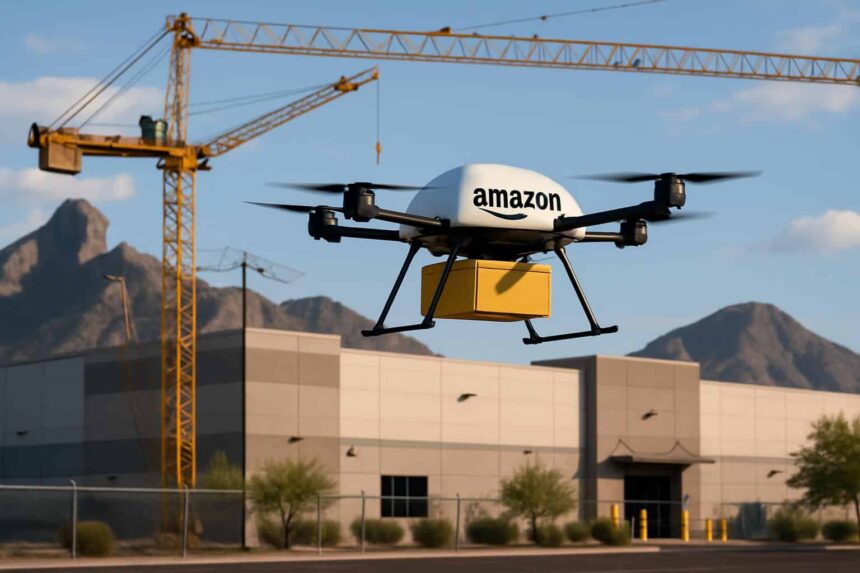Amazon is set to resume its Prime Air drone delivery service in Arizona on Friday, weeks after a crash involving two drones and a construction crane forced the company to halt operations. The decision has reignited debates over the safety and future of autonomous aerial delivery systems.
In late September, two Amazon Prime Air drones collided with the boom of a crane near the company’s Tolleson delivery site. Both drones were destroyed in the crash, prompting Amazon to immediately suspend flights in the area.
The drones had been operating in Arizona since November 2024, delivering small packages—typically under five pounds—to customers in the West Valley. The crash added to a string of pauses in the service, including earlier suspensions in Texas and Arizona tied to safety concerns and system updates.
Amazon’s Review and Response
Following an internal review, Amazon stated it found no faults with its drone hardware or supporting technology. Instead, the company pointed to the need for enhanced safeguards around moving obstructions such as cranes.
The company announced it would implement new visual inspection protocols and increase monitoring of flight paths to prevent similar incidents. Amazon also confirmed it is cooperating with investigations by the Federal Aviation Administration (FAA) and the National Transportation Safety Board (NTSB).
“Safety remains our highest priority,” the company said in a statement, pledging that drone deliveries will resume cautiously with these new measures in place.
For customers in Arizona, the return of drone deliveries promises faster access to goods but also rekindles questions about the risks of having autonomous machines flying over neighborhoods.
For regulators, the crash is another reminder of the complexity of integrating drones into U.S. airspace. Federal agencies now face the challenge of balancing innovation with public safety, while ensuring companies like Amazon are held accountable for incidents.
Competitors and smaller drone firms are also watching closely. Amazon’s setbacks and responses may serve as a blueprint—or a cautionary tale—for others pursuing autonomous delivery.
Why it Matters
The crash highlights how quickly public trust in autonomous systems can erode. Years of research and testing can be undermined by a single incident. For Amazon, this is more than a technical challenge—it is a reputational one.
The future of drone delivery hinges not only on engineering solutions but also on public confidence that these machines can operate safely in complex urban environments. Cities worldwide, including those in Africa exploring drone logistics, will be weighing these risks as they consider adopting similar systems.
As Amazon restarts operations in Arizona, attention will turn to whether its new protocols can prevent further mishaps. The outcome of federal investigations will also shape the regulatory path forward.
Drone delivery is still in its infancy, and every setback is magnified. For now, Amazon must prove that its drones can coexist with everyday infrastructure—and that convenience will not come at the cost of safety.
Talking Points
Amazon’s Arizona crash reminds us that even the most advanced companies cannot guarantee safety when new technologies hit real-world complexity. If a trillion-dollar giant like Amazon struggles with drones avoiding cranes, what happens when less-resourced startups push similar innovations in emerging markets?
Regulators are caught in a bind: allow innovation and risk public safety, or slow things down and risk stifling progress. Yet, should customers be the testing ground for these high-stakes experiments? In Africa, where regulation often lags behind innovation, this is a wake-up call—do we have frameworks ready for drone deliveries before tech giants bring them to our skies?
While Amazon and others battle to dominate drone logistics in the West, Africa risks being left as a consumer of imported solutions. The continent needs its own drone innovators—especially as logistics challenges here are often more acute than in Arizona. Imagine drones solving rural medical supply gaps in Nigeria or Kenya, but under African-built systems, not just imported models.





